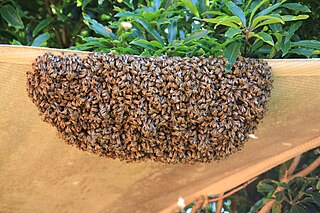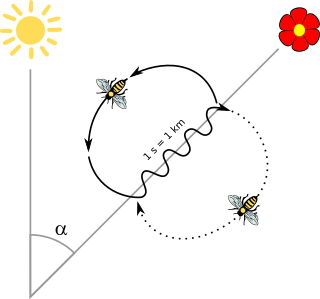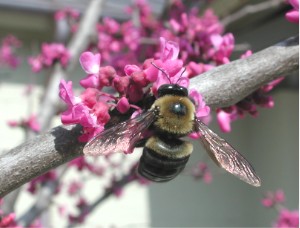
A honey bee is a eusocial flying insect within the genus Apis of the bee clade, all native to mainland Afro-Eurasia. After bees spread naturally throughout Africa and Eurasia, humans became responsible for the current cosmopolitan distribution of honey bees, introducing multiple subspecies into South America, North America, and Australia.

The Africanized bee, also known as the Africanized honey bee (AHB) and colloquially as the "killer bee", is a hybrid of the western honey bee, produced originally by crossbreeding of the East African lowland honey bee (A. m. scutellata) with various European honey bee subspecies such as the Italian honey bee (A. m. ligustica) and the Iberian honey bee (A. m. iberiensis).

Bee learning and communication includes cognitive and sensory processes in all kinds of bees, that is the insects in the seven families making up the clade Anthophila. Some species have been studied more extensively than others, in particular Apis mellifera, or European honey bee. Color learning has also been studied in bumblebees.

A worker bee is any female bee that lacks the reproductive capacity of the colony's queen bee and carries out the majority of tasks needed for the functioning of the hive. While worker bees are present in all eusocial bee species, the term is rarely used for bees other than honey bees, particularly the European honey bee. Worker bees of this variety are responsible for approximately 80% of the world's crop pollination services.

Warwick Estevam Kerr was a Brazilian agricultural engineer, geneticist, entomologist, professor and scientific leader, notable for his discoveries in the genetics and sex determination of bees. The Africanized bee in the western hemisphere is directly descended from 26 Tanzanian queen bees accidentally released by one of his assistant bee-keepers. When reassembling a hive, the assistant forgot to install the queen excluder. This occurred in 1957 in Rio Claro, São Paulo in the southeast of Brazil from hives operated by Kerr, who had interbred honey bees from Europe and southern Africa.

Varroa destructor, the Varroa mite, is an external parasitic mite that attacks and feeds on honey bees and is one of the most damaging honey bee pests in the world. A significant mite infestation leads to the death of a honey bee colony, usually in the late autumn through early spring. Without management for Varroa mite, honey bee colonies typically collapse within 2 to 3 years in temperate climates. These mites can infest Apis mellifera, the western honey bee, and Apis cerana, the Asian honey bee. Due to very similar physical characteristics, this species was thought to be the closely related Varroa jacobsoni prior to 2000, but they were found to be two separate species after DNA analysis.

Swarming is a honey bee colony's natural means of reproduction. In the process of swarming, a single colony splits into two or more distinct colonies.

Waggle dance is a term used in beekeeping and ethology for a particular figure-eight dance of the honey bee. By performing this dance, successful foragers can share information about the direction and distance to patches of flowers yielding nectar and pollen, to water sources, or to new nest-site locations with other members of the colony.

The dwarf honey bee, Apis florea, is one of two species of small, wild honey bees of southern and southeastern Asia. It has a much wider distribution than its sister species, Apis andreniformis. First identified in the late 18th century, Apis florea is unique for its morphology, foraging behavior and defensive mechanisms like making a piping noise. Apis florea have open nests and small colonies, which makes them more susceptible to predation than cavity nesters with large numbers of defensive workers. These honey bees are important pollinators and therefore commodified in countries like Cambodia.

The Cape honey bee or Cape bee is a southern South African subspecies of the western honey bee. They play a major role in South African agriculture and the economy of the Western Cape by pollinating crops and producing honey in the Western Cape region of South Africa. The species is endemic to the Western Cape region of South Africa on the coastal side of the Cape Fold mountain range.
Vitellogenin is a precursor of egg yolk that transports protein and some lipid from the liver through the blood to the growing oocytes where it becomes part of the yolk. Normally, it is only found in the blood or hemolymph of females, and can therefore be used as a biomarker in vertebrates of exposure to environmental estrogens which stimulate elevated levels in males as well as females. "Vitellogenin" is a synonymous term for the gene and the expressed protein. The protein product is classified as a glycolipoprotein, having properties of a sugar, fat and protein. It belongs to a family of several lipid transport proteins.

Bees can suffer serious effects from toxic chemicals in their environments. These include various synthetic chemicals, particularly insecticides, as well as a variety of naturally occurring chemicals from plants, such as ethanol resulting from the fermentation of organic materials. Bee intoxication can result from exposure to ethanol from fermented nectar, ripe fruits, and manmade and natural chemicals in the environment.
A tremble dance is a dance performed by forager honey bees of the species Apis mellifera to recruit more receiver honey bees to collect nectar from the workers.

The East African lowland honey bee is a subspecies of the western honey bee. It is native to central, southern and eastern Africa, though at the southern extreme it is replaced by the Cape honey bee. This subspecies has been determined to constitute one part of the ancestry of the Africanized bees spreading through North and South America.

The western honey bee or European honey bee is the most common of the 7–12 species of honey bees worldwide. The genus name Apis is Latin for 'bee', and mellifera is the Latin for 'honey-bearing' or 'honey-carrying', referring to the species' production of honey.
The genetics of social behavior is an area of research that attempts to address the question of the role that genes play in modulating the neural circuits in the brain which influence social behavior. Model genetic species, such as D.melanogaster and Apis mellifera, have been rigorously studied and proven to be instrumental in developing the science of genetics. Many examples of genetic factors of social behavior have been derived from a bottom-up method of altering a gene and observing the change it produces in an organism. Sociogenomics is an integrated field that accounts for the complete cellular genetic complement of an organism from a top-down approach, accounting for all biotic influences that effect behavior on a cellular level.
Gene Ezia Robinson is an American entomologist, Director of the Carl R. Woese Institute for Genomic Biology and National Academy of Sciences member. He pioneered the application of genomics to the study of social behavior and led the effort to sequence the honey bee genome. On February 10, 2009, his research was famously featured in an episode of The Colbert Report whose eponymous host referred to the honey Dr. Robinson sent him as "pharmaceutical-grade hive jive".

The California carpenter bee or Western carpenter bee, Xylocopa californica, is a species of carpenter bee in the order Hymenoptera, and it is native to western North America.














